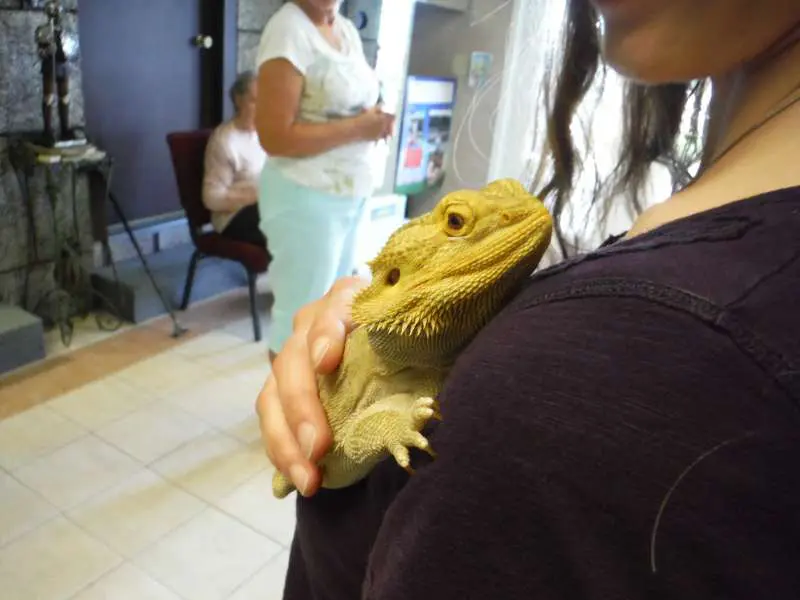
- Lulu the bearded dragon at the Creation Experience Museum in Branson, MO, as held by the author. Photo copyright Sara J. Bruegel 2015
“Meet Lulu – she’s a bearded dragon” I explained to the delighted kids as I knelt down so they could stroke the lizard sitting on my shoulder. Some timidly touched Lulu, surprised to find that she didn’t feel as prickly as she looked; others asked as many questions as they could think of about her. When I held her the first time, I was surprised at how docile and responsive she was, though I think my cold hands made her squirm a little. Sometimes she did act up a little bit, trying to get down and clinging to my hair or necklace with her sharp curled claws, but I learned how to manage her (giving her lectures for bad behavior, as needed) after a little practice.

Though native to Australia, bearded dragons like Lulu (classified in the genus, Pogona) are known for being very good pets. In captivity, their diet usually consists of crickets and nutritious fruits and vegetables. These creatures generally are not very picky eaters. Radiation from natural sunlight can be very important for the health of a bearded dragon, helping their digestion among other things. Most of the time Lulu lives indoors, equipped with special radiation lamps, warmers, and a basking rock in her display tank, but she does take vacations from her photogenic glam job (greeting museum guests) to spend time outside, soaking in a little sunshine to enhance her natural beauty.

Like many of the kids noticed, she looks very prickly, but when you actually touch her she is softer than most people would expect. That’s part of her defense tactic of looking intimidating, just like the expandable “beard” that these creatures are named for. Both the male and female bearded dragons have a beard that puffs out and turns dark when they feel threatened, though males are generally known for using their beard more often. An interesting way that these creatures communicate with each other is through head bobbing to show dominance and arm waving (they literally pick up one of their arms and wave it in a circular motion) to show submission.
Female bearded dragons lay a clutch of up to 24 eggs at a time and can lay up to 9 clutches each year. Recent research has been done on how temperature influences whether the eggs in a clutch hatch as males or females, showing that hotter temperatures lead to all females hatching from a clutch. This is not a new phenomenon, as “temperature-dependent sex determination” is known to occur in other reptiles, such as some types of turtles and crocodiles. Though many speculations have been made about what this could mean for the Australian bearded dragon and other aspects of biology, what it seems to imply most clearly is that there is a lot more than we realize at first glance that goes into development of embryos and their genetics. Living creatures are very complex – marvelously designed by the Creator to carry out His command to fill the earth, even equipped with the beautiful defense structures they need to survive in our fallen world after man brought death into God’s perfect creation through sin.
Copyright Sara J. Bruegel, July 2015
References:
- “Inland Bearded Dragon” fact sheet from Smithsonian National Zoological Park. Last accessed July 24, 2015. https://nationalzoo.si.edu/Animals/ReptilesAmphibians/Facts/FactSheets/Inlandbeardeddragon.cfm
- Ed Young. “Hot Wild Dragons Set Sex Through Temperature Not Genes”. National Geographic. “Not Exactly Rocket Science”. Published July 1, 2015. http://phenomena.nationalgeographic.com/2015/07/01/hot-wild-dragons-set-sex-through-temperature-not-genes/
- Randy Guzzilla. “A Response to ‘Does Natural Selection Exist?’: Creatures’ Adaptation Explained by the Design-based, Organism-driven Approach: Part 3”. Answers Research Journal. Answers in Genesis. Published November 5, 2014. https://answersingenesis.org/natural-selection/response-does-natural-selection-exist-part3/
- Special thanks to Dr. Rod Butterworth and staff of Creation Ministries of the Ozarks and Creation Experience Museum in Branson, Missouri where Miss Lulu the bearded dragon makes her home





